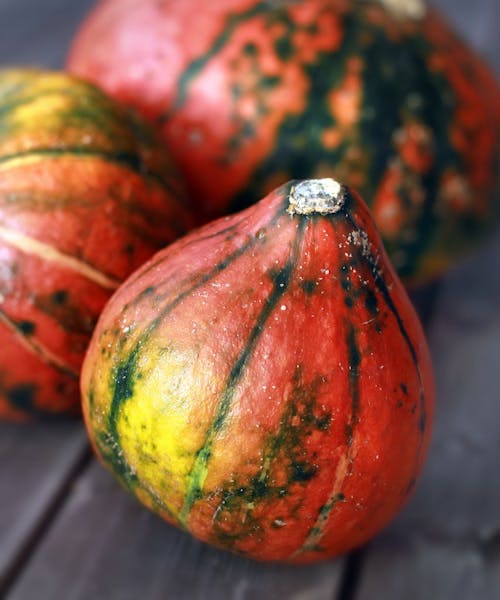Even on the grayest days, the bright orange, silvery blues and moon-colored squashes light up market stalls. "Make steamy soup, spicy stew, lush pie," they seem to say. I can never decide among the colors, shapes and sizes and usually end up buying more than I can haul. And why not? They'll keep. Unlike the delicate, demanding crops of summer -- fragrant tomatoes, sugary corn and tender peas -- these hearty characters will wait patiently for me, decorating the table or front stoop.
Given its generally neutral flavor and creamy texture, winter squash is one of the most flexible and adaptable vegetables. It's great in Indian curries, African stews, Asian stir-fries, Italian ravioli, Mexican soups and good old American pie. And it makes a terrific serving container for any dish.
At the farmers markets you'll find a large selection of heirloom varieties with interesting though subtle variations in flavor and texture. Know that a squash's skin toughens as it ages, so the fresher it is, the easier it will be to peel, the more quickly it will cook, and the more distinct its taste will be.
Here is a partial list of the types of squash being harvested now:
Acorn: This old standby, in green or pale gold, is especially good when fresh from local farms. It's easy to slice, seed and roast with a little butter, chopped apples and craisins.
Ambercup: Related to the buttercup, this looks like a small pumpkin with its bright orange skin. The equally bright flesh has a sweet-potato-like flavor. It's easy to peel, cube and roast.
Autumn cup: Dark green and round with bright yellow-orange flesh that is moist and flavorful, this squash is easily peeled and cubed.
Buttercup: A member of the "turban" family, this thick-skinned, dark green squash sports orange flesh that's very creamy and among the sweetest tasting.
Butternut: The go-to squash for busy people, butternut is easy to peel and cube and has a wonderful dense, sweet flesh that roasts up to be creamy.
Carnival: Cream-colored with bright orange spots, or pale green with green vertical stripes, it looks a little like a round acorn squash but has a sweeter flavor and creamier texture.
Cheese wheel or cheese pumpkin: Squat, round, resembling a wheel of cheese, this squash is very sweet and dense, excellent for pies. As it looks like a pumpkin, use it as a jack-o-lantern, then cook and enjoy.
Cinderella pumpkin: Squat, round and deep orange, this resembles the fairy-tale coach. Pretty as it is for a jack-o-lantern or table decoration, its flesh tastes distinctly of pumpkin, and is thick, sweet and firm. It's great in soups, pies and crème brûlée.
Delicata: Sometimes called the peanut or Bohemian squash, this has a thin skin that's relatively easy to peel and a sweet, flavorful flesh that tastes like a cross between corn and sweet potatoes.
Golden nugget: It looks like a pale, round pumpkin with its pale orange skin and flesh. It is great cooked whole (though pierce it first) before splitting open to seed it; serve with butter or turn into a purée or soup. The flavor is mild and the flesh light.
Hubbard: An old-fashioned variety, it ranges from silvery gray to mossy green and, when cut, reveals a pale orange, dry and dense flesh that suggests the flavor of sweet potatoes. Blue Hubbards can grow to be enormous and their skin can be "warty" and very tough. It's best to cut this one into chunks and roast it to serve as is or purée it for a soup, stew or pie.
Kabocha: The generic name for squash in Japanese, kabocha most often refers to the blue-green squash with bright orange flesh that cooks up dense, dry and a bit flaky.
Red Kuri: Resembling a small bright pumpkin without ridges, this relatively thin-skinned squash has a bright orange flesh with hints of sweet potatoes and chestnuts.
Sweet dumpling: Tiny, round and plump, these have a mild and moist flesh and are pretty when simply roasted or served stuffed or whole.
Triamble: An heirloom variety with a blue-gray, ridged exterior, this is a bit moister than the Blue Hubbard and not quite as sweet. Its skin is tough and difficult to peel, so roast it beforehand.
Turban: Named for its shape, these vary in color from orange, to green or white. The flavor of its golden-yellow flesh resembles hazelnuts.
Beth Dooley is a Minneapolis author.

